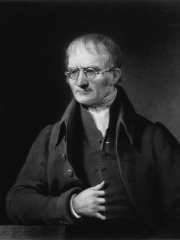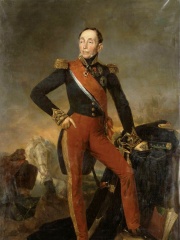WRITER
Germaine de Staël
1766 - 1817

 Germaine de Staël
Germaine de Staël
Anne Louise Germaine de Staël-Holstein (French: [an lwiz ʒɛʁmɛn də stal ɔlstajn]; née Necker; 22 April 1766 – 14 July 1817), commonly known as Madame de Staël ( də-STAHL; French: [madam də stal]), was a prominent philosopher, woman of letters, and political theorist in both Parisian and Genevan intellectual circles. She was the daughter of banker and French finance minister Jacques Necker and Suzanne Curchod, a respected salonist and writer. Throughout her life, she held a moderate stance during the tumultuous periods of the French Revolution and the Napoleonic era, persisting until the time of the French Restoration. Her presence at critical events such as the Estates General of 1789 and the 1789 Declaration of the Rights of Man and of the Citizen underscored her engagement in the political discourse of her time. Read more on Wikipedia
Her biography is available in 54 different languages on Wikipedia (up from 53 in 2024). Germaine de Staël is the 282nd most popular writer (down from 248th in 2024), the 313th most popular biography from France (down from 298th in 2019) and the 45th most popular French Writer.
Germaine de Staël was a French-Swiss author who is most famous for her novel Corinne, or Italy, which was published in 1807.
Memorability Metrics
Page views of Germaine de Staël by language
Among WRITERS
Among writers, Germaine de Staël ranks 282 out of 7,302. Before her are Gao Xingjian, Pär Lagerkvist, Anna Komnene, Vladimir Mayakovsky, Ralph Waldo Emerson, and Valmiki. After her are Isabel Allende, Kenzaburō Ōe, Pierre Corneille, Ludovico Ariosto, Marcus Terentius Varro, and Eckhart Tolle.
Most Popular Writers in Wikipedia
Go to all RankingsGao Xingjian
1940 - Present
HPI: 76.23
Rank: 276
Pär Lagerkvist
1891 - 1974
HPI: 76.22
Rank: 277
Anna Komnene
1083 - 1153
HPI: 76.22
Rank: 278
Vladimir Mayakovsky
1893 - 1930
HPI: 76.22
Rank: 279
Ralph Waldo Emerson
1803 - 1882
HPI: 76.21
Rank: 280
Valmiki
80 BC - 2 BC
HPI: 76.21
Rank: 281
Germaine de Staël
1766 - 1817
HPI: 76.21
Rank: 282
Isabel Allende
1942 - Present
HPI: 76.20
Rank: 283
Kenzaburō Ōe
1935 - 2023
HPI: 76.20
Rank: 284
Pierre Corneille
1606 - 1684
HPI: 76.18
Rank: 285
Ludovico Ariosto
1474 - 1533
HPI: 76.15
Rank: 286
Marcus Terentius Varro
116 BC - 27 BC
HPI: 76.15
Rank: 287
Eckhart Tolle
1948 - Present
HPI: 76.13
Rank: 288
Contemporaries
Among people born in 1766, Germaine de Staël ranks 4. Before her are John Dalton, Thomas Robert Malthus, and Joseph Radetzky von Radetz. After her are Charlotte, Princess Royal, Emmanuel de Grouchy, marquis de Grouchy, Nikolay Karamzin, Armand-Emmanuel de Vignerot du Plessis, Duc de Richelieu, Franz Xaver Süssmayr, William Hyde Wollaston, Johanna Schopenhauer, and José Gaspar Rodríguez de Francia. Among people deceased in 1817, Germaine de Staël ranks 4. Before her are Jane Austen, Princess Charlotte of Wales, and Tadeusz Kościuszko. After her are Charles Messier, André Masséna, Karađorđe, Marie Walewska, Martin Heinrich Klaproth, Nikolaus Joseph von Jacquin, Johann Ludwig Burckhardt, and Duke Louis of Württemberg.
Others Born in 1766
Go to all RankingsJohn Dalton
CHEMIST
1766 - 1844
HPI: 83.53
Rank: 1
Thomas Robert Malthus
ECONOMIST
1766 - 1834
HPI: 80.30
Rank: 2
Joseph Radetzky von Radetz
MILITARY PERSONNEL
1766 - 1858
HPI: 77.49
Rank: 3
Germaine de Staël
WRITER
1766 - 1817
HPI: 76.21
Rank: 4
Charlotte, Princess Royal
COMPANION
1766 - 1828
HPI: 75.10
Rank: 5
Emmanuel de Grouchy, marquis de Grouchy
MILITARY PERSONNEL
1766 - 1847
HPI: 71.25
Rank: 6
Nikolay Karamzin
WRITER
1766 - 1826
HPI: 69.37
Rank: 7
Armand-Emmanuel de Vignerot du Plessis, Duc de Richelieu
POLITICIAN
1766 - 1822
HPI: 69.32
Rank: 8
Franz Xaver Süssmayr
COMPOSER
1766 - 1803
HPI: 69.11
Rank: 9
William Hyde Wollaston
CHEMIST
1766 - 1828
HPI: 68.56
Rank: 10
Johanna Schopenhauer
WRITER
1766 - 1838
HPI: 67.28
Rank: 11
José Gaspar Rodríguez de Francia
POLITICIAN
1766 - 1840
HPI: 67.23
Rank: 12
Others Deceased in 1817
Go to all RankingsJane Austen
WRITER
1775 - 1817
HPI: 80.62
Rank: 1
Princess Charlotte of Wales
POLITICIAN
1796 - 1817
HPI: 77.53
Rank: 2
Tadeusz Kościuszko
MILITARY PERSONNEL
1746 - 1817
HPI: 76.24
Rank: 3
Germaine de Staël
WRITER
1766 - 1817
HPI: 76.21
Rank: 4
Charles Messier
ASTRONOMER
1730 - 1817
HPI: 75.05
Rank: 5
André Masséna
MILITARY PERSONNEL
1758 - 1817
HPI: 73.87
Rank: 6
Karađorđe
POLITICIAN
1768 - 1817
HPI: 73.72
Rank: 7
Marie Walewska
POLITICIAN
1786 - 1817
HPI: 72.16
Rank: 8
Martin Heinrich Klaproth
CHEMIST
1743 - 1817
HPI: 71.51
Rank: 9
Nikolaus Joseph von Jacquin
BIOLOGIST
1727 - 1817
HPI: 69.54
Rank: 10
Johann Ludwig Burckhardt
WRITER
1784 - 1817
HPI: 68.82
Rank: 11
Duke Louis of Württemberg
POLITICIAN
1756 - 1817
HPI: 68.56
Rank: 12
In France
Among people born in France, Germaine de Staël ranks 313 out of 6,770. Before her are Gilles de Rais (1405), Robert II of France (972), Josquin des Prez (1450), Raynald of Châtillon (1123), Jean Gabin (1904), and Louis Antoine, Duke of Angoulême (1775). After her are Philippe I, Duke of Orléans (1640), Henry Louis Le Chatelier (1850), Pierre Corneille (1606), Joseph Fouché (1759), Patrick Modiano (1945), and Louis, Duke of Burgundy (1682).
Others born in France
Go to all RankingsGilles de Rais
EXTREMIST
1405 - 1440
HPI: 76.41
Rank: 307
Robert II of France
POLITICIAN
972 - 1031
HPI: 76.37
Rank: 308
Josquin des Prez
COMPOSER
1450 - 1521
HPI: 76.33
Rank: 309
Raynald of Châtillon
NOBLEMAN
1123 - 1187
HPI: 76.28
Rank: 310
Jean Gabin
ACTOR
1904 - 1976
HPI: 76.22
Rank: 311
Louis Antoine, Duke of Angoulême
NOBLEMAN
1775 - 1844
HPI: 76.22
Rank: 312
Germaine de Staël
WRITER
1766 - 1817
HPI: 76.21
Rank: 313
Philippe I, Duke of Orléans
NOBLEMAN
1640 - 1701
HPI: 76.21
Rank: 314
Henry Louis Le Chatelier
CHEMIST
1850 - 1936
HPI: 76.20
Rank: 315
Pierre Corneille
WRITER
1606 - 1684
HPI: 76.18
Rank: 316
Joseph Fouché
PUBLIC WORKER
1759 - 1820
HPI: 76.13
Rank: 317
Patrick Modiano
WRITER
1945 - Present
HPI: 76.09
Rank: 318
Louis, Duke of Burgundy
POLITICIAN
1682 - 1712
HPI: 76.04
Rank: 319
Among WRITERS In France
Among writers born in France, Germaine de Staël ranks 45. Before her are Frédéric Mistral (1830), George Sand (1804), Roger Martin du Gard (1881), Louis-Ferdinand Céline (1894), Annie Ernaux (1940), and Prosper Mérimée (1803). After her are Pierre Corneille (1606), Patrick Modiano (1945), Alphonse Daudet (1840), François de La Rochefoucauld (1613), Guillaume de Machaut (1300), and Chrétien de Troyes (1135).
Frédéric Mistral
1830 - 1914
HPI: 78.05
Rank: 39
George Sand
1804 - 1876
HPI: 77.79
Rank: 40
Roger Martin du Gard
1881 - 1958
HPI: 77.76
Rank: 41
Louis-Ferdinand Céline
1894 - 1961
HPI: 77.61
Rank: 42
Annie Ernaux
1940 - Present
HPI: 77.55
Rank: 43
Prosper Mérimée
1803 - 1870
HPI: 77.10
Rank: 44
Germaine de Staël
1766 - 1817
HPI: 76.21
Rank: 45
Pierre Corneille
1606 - 1684
HPI: 76.18
Rank: 46
Patrick Modiano
1945 - Present
HPI: 76.09
Rank: 47
Alphonse Daudet
1840 - 1897
HPI: 75.83
Rank: 48
François de La Rochefoucauld
1613 - 1680
HPI: 75.81
Rank: 49
Guillaume de Machaut
1300 - 1377
HPI: 75.77
Rank: 50
Chrétien de Troyes
1135 - 1185
HPI: 75.68
Rank: 51























































